Tracking of Internal Granular Progenitors Responding to Valproic Acid in the Cerebellar Cortex of Infant Ferrets
Abstract
1. Introduction
2. Materials and Methods
2.1. Animals
2.2. Preparation of Tissue Sections
2.3. Immunohistochemical Procedures
2.4. Evaluation of Cell Density
2.5. Statistical Treatment
3. Results
3.1. Gross Structures of the Cerebellum
3.2. Densities of EdU- and BrdU-Labeled Cells
3.3. Double Immunofluorescence Staining for Calbindin D28k and Parvalbumin with EdU and BrdU Labeling
3.4. Immunofluorescence Staining for Various Markers with EdU and BrdU Labeling
3.4.1. Ratio of Pax6 Immunostaining
3.4.2. Ratio of NeuN Immunostaining
3.4.3. Ratio of PCNA Immunostaining
3.4.4. Ratio of S100 Immunostaining
3.4.5. Ratio of BLBP Immunostaining
3.5. Densities of Cells Immunostained for Various Marker Antigens
4. Discussion
5. Conclusions
Supplementary Materials
Author Contributions
Funding
Institutional Review Board Statement
Informed Consent Statement
Data Availability Statement
Conflicts of Interest
References
- Fujita, S.; Shimada, M.; Nakamura, T. H3-thymidine autoradiographic studies on the cell proliferation and differentiation in the external and the internal granular layers of the mouse cerebellum. J. Comp. Neurol. 1966, 128, 191–208. [Google Scholar] [CrossRef] [PubMed]
- Galas, L.; Bénard, M.; Lebon, A.; Komuro, Y.; Schapman, D.; Vaudry, H.; Vaudry, D.; Komuro, H. Postnatal migration of cerebellar interneurons. Brain Sci. 2017, 7, 62. [Google Scholar] [CrossRef] [PubMed]
- Consalez, G.G.; Goldowitz, D.; Casoni, F.; Hawkes, R. Origins, development, and compartmentation of the granule cells of the cerebellum. Front. Neural Circuits 2021, 14, 611841. [Google Scholar] [CrossRef] [PubMed]
- Altman, J. Autoradiographic and histological studies of postnatal neurogenesis. III. Dating the time of production and onset of differentiation of cerebellar micro neurons in rats. J. Comp. Neurol. 1969, 136, 269–294. [Google Scholar] [CrossRef] [PubMed]
- Altman, J. Postnatal development of the cerebellar cortex in the rat. I. The external germinal layer and the transitional molecular layer. J. Comp. Neurol. 1972, 145, 353–398. [Google Scholar] [CrossRef]
- Iulianella, A.; Wingate, R.J.; Moens, C.B.; Capaldo, E. The generation of granule cells during the development and evolution of the cerebellum. Dev. Dyn. 2019, 248, 506–513. [Google Scholar] [CrossRef]
- Christensson, M.; Broman, J.; Garwicz, M. Time course of cerebellar morphological development in postnatal ferrets: Ontogenetic and comparative perspectives. J. Comp. Neurol. 2007, 501, 916–930. [Google Scholar] [CrossRef]
- Kamiya, S.; Sawada, K. Immunohistochemical characterization of postnatal changes in cerebellar cortical cytoarchitectures in ferrets. Anat. Rec. 2021, 304, 413–424. [Google Scholar] [CrossRef]
- Sawada, K.; Kamiya, S. Differential staining patterns of immunohistochemical markers for neurogenesis staging in the premature cerebellum of ferrets and mice. Congenit. Anom. 2023, 63, 116–120. [Google Scholar] [CrossRef]
- Kamiya, S.; Kobayashi, T.; Sawada, K. Induction of cerebellar cortical neurogenesis immediately following valproic acid exposure in ferret kits. Front. Neurosci. 2023, 17, 1318688. [Google Scholar] [CrossRef]
- Phiel, C.J.; Zhang, F.; Huang, E.Y.; Guenther, M.G.; Lazar, M.A.; Klein, P.S. Histone deacetylase is a direct target of valproic acid, a potent anticonvulsant, mood stabilizer, and teratogen. J. Biol. Chem. 2001, 276, 36734–36741. [Google Scholar] [CrossRef]
- Gundersen, H.J.G. Notes on the estimation of the numerical density of arbitrary profiles: The edge effect. J. Microsc. 1977, 111, 219–223. [Google Scholar] [CrossRef]
- Sawada, K.; Horiuchi-Hirose, M.; Saito, S.; Aoki, I. Male prevalent enhancement of leftward asymmetric development of the cerebellar cortex in ferrets (Mustela putorius). Laterality 2015, 20, 723–737. [Google Scholar] [CrossRef] [PubMed]
- Bastianelli, E. Distribution of calcium-binding proteins in the cerebellum. Cerebellum 2003, 2, 242–262. [Google Scholar] [CrossRef] [PubMed]
- Chung, S.-H.; Kim, C.-T.; Jung, Y.-H.; Lee, N.-S.; Jeong, Y.-G. Early cerebellar granule cell migration in the mouse embryonic development. Anat. Cell Biol. 2010, 43, 86–95. [Google Scholar] [CrossRef]
- Wolf, H.K.; Buslei, R.; Schmidt-Kastner, R.; Schmidt-Kastner, P.K.; Pietsch, T.; Wiestler, O.D.; Blümcke, I. NeuN: A useful neuronal marker for diagnostic histopathology. J. Histochem. Cytochem. 1996, 44, 1167–1171. [Google Scholar] [CrossRef] [PubMed]
- Weyer, A.; Schilling, K. Developmental and cell type-specific expression of the neuronal marker NeuN in the murine cerebellum. J. Neurosci. Res. 2003, 73, 400–409. [Google Scholar] [CrossRef] [PubMed]
- Vives, V.; Alonso, G.; Solal, A.C.; Joubert, D.; Legraverend, C. Visualization of S100β-positive neurons and glia in the central nervous system of EGFP transgenic mice. J. Comp. Neurol. 2003, 457, 404–419. [Google Scholar] [CrossRef]
- Ahlfeld, J.; Filser, S.; Schmidt, F.; Wefers, A.K.; Merk, D.J.; Glaß, R.; Herms, J.; Schüller, U. Neurogenesis from Sox2 expressing cells in the adult cerebellar cortex. Sci. Rep. 2017, 7, 6137. [Google Scholar] [CrossRef]
- Sawada, K.; Kamiya, S.; Aoki, I. Neonatal valproic acid exposure produces altered gyrification related to increased parvalbumin-immunopositive neuron density with thickened sulcal floors. PLoS ONE 2021, 20, 16. [Google Scholar] [CrossRef]
- Tsai, L.K.; Tsai, M.S.; Ting, C.H.; Li, H. Multiple therapeutic effects of valproic acid in spinal muscular atrophy model mice. J. Mol. Med. 2008, 86, 1243–1254. [Google Scholar] [CrossRef]
- Song, N.; Boku, S.; Nakagawa, S.; Kato, A.; Toda, H.; Takamura, N.; Omiya, Y.; Kitaichi, Y.; Inoue, T.; Koyama, T. Mood stabilizers commonly restore staurosporine-induced increase of p53 expression and following decrease of Bcl-2 expression in SH-SY5Y cells. Prog. Neuropsychopharmacol. Biol. Psychiatry 2012, 38, 183–189. [Google Scholar] [CrossRef][Green Version]
- Nikolian, V.C.; Dennahy, I.S.; Higgins, G.A.; Williams, A.M.; Weykamp, M.; Georgoff, P.E.; Eidy, H.; Ghandour, M.H.; Chang, P.; Alam, H.B. Transcriptomic changes following valproic acid treatment promote neurogenesis and minimize secondary brain injury. J. Trauma Acute Care Surg. 2018, 84, 459–465. [Google Scholar] [CrossRef] [PubMed]
- Krahe, T.E.; Filgueiras, C.C.; Medina, A.E. Effects of developmental alcohol And valproic acid exposure on play behavior of ferrets. Int. J. Dev. Neurosci. 2016, 52, 75–81. [Google Scholar] [CrossRef] [PubMed]
- Kriegstein, A.; Alvarez-Buylla, A. The glial nature of embryonic and adult neural stem cells. Annu. Rev. Neurosci. 2009, 32, 149–184. [Google Scholar] [CrossRef] [PubMed]
- Yuasa, S.; Kawamura, K.; Kuwano, R.; Ono, K. Neuron-glia interrelations during migration of Purkinje cells in the mouse embryonic cerebellum. Int. J. Dev. Neurosci. 1996, 14, 429–438. [Google Scholar] [PubMed]
- Youssef, M.; Krish, V.S.; Kirshenbaum, G.S.; Atsak, P.; Lass, T.J.; Lieberman, S.R.; Leonardo, E.D.; Dranovsky, A. Ablation of proliferating neural stem cells during early life is sufficient to reduce adult hippocampal neurogenesis. Hippocampus 2018, 28, 586–601. [Google Scholar] [CrossRef]
- Valera, E.M.; Faraone, S.V.; Biederman, J.; Poldrack, R.A.; Seidman, L.J. Functional neuroanatomy of working memory in adults with attention-deficit/hyperactivity disorder. Biol. Psychiatry. 2005, 57, 439–447. [Google Scholar] [CrossRef] [PubMed]
- Hu, D.; Shen, H.; Zhou, Z. Functional asymmetry in the cerebellum: A brief review. Cerebellum 2008, 7, 304–313. [Google Scholar] [CrossRef]
- Ciricugno, A.; Ferrari, C.; Rusconi, M.L.; Cattaneo, Z. The left posterior cerebellum is involved in orienting attention along the mental number line: An online-TMS study. Neuropsychologia 2020, 143, 107497. [Google Scholar] [CrossRef]
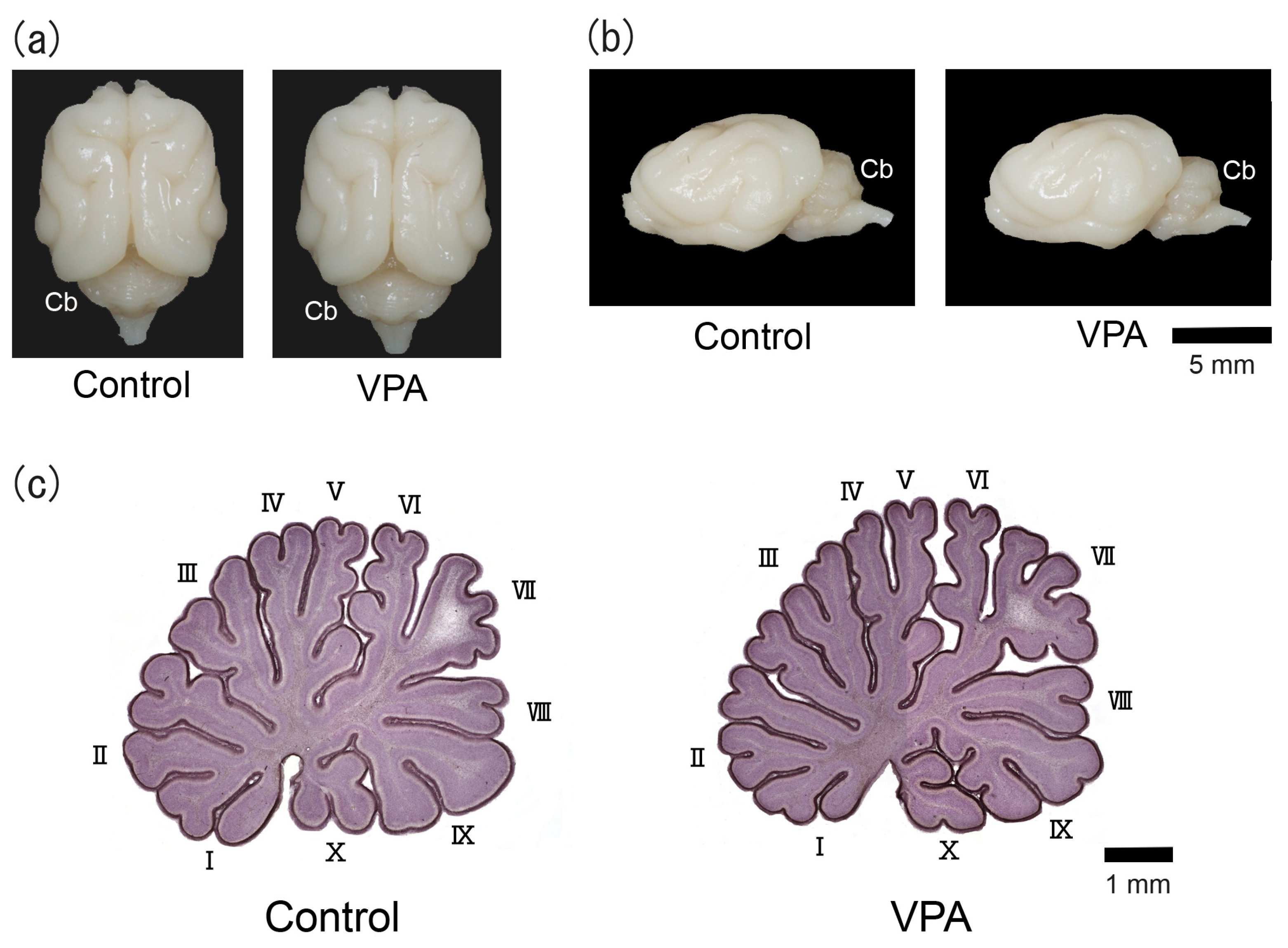
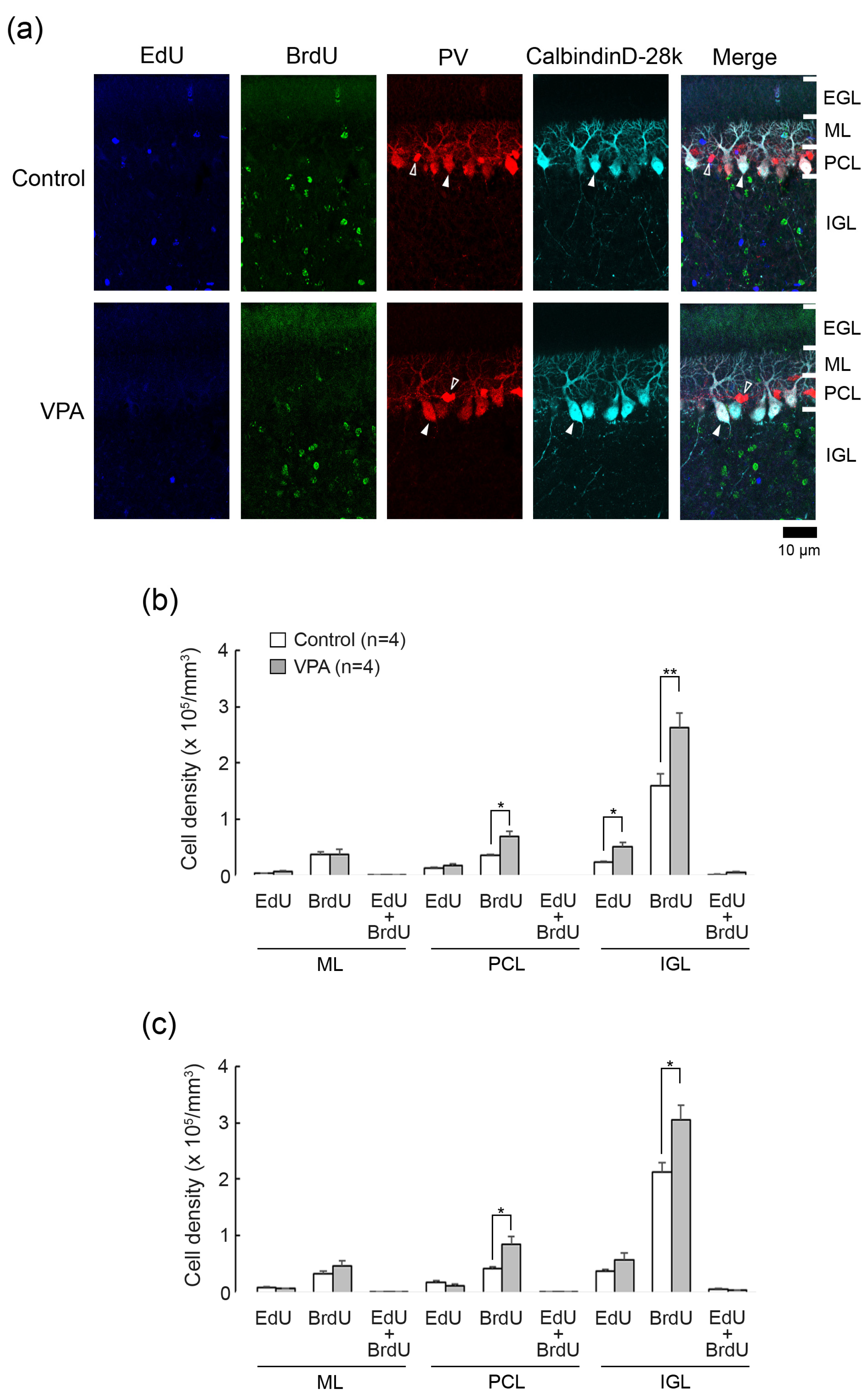
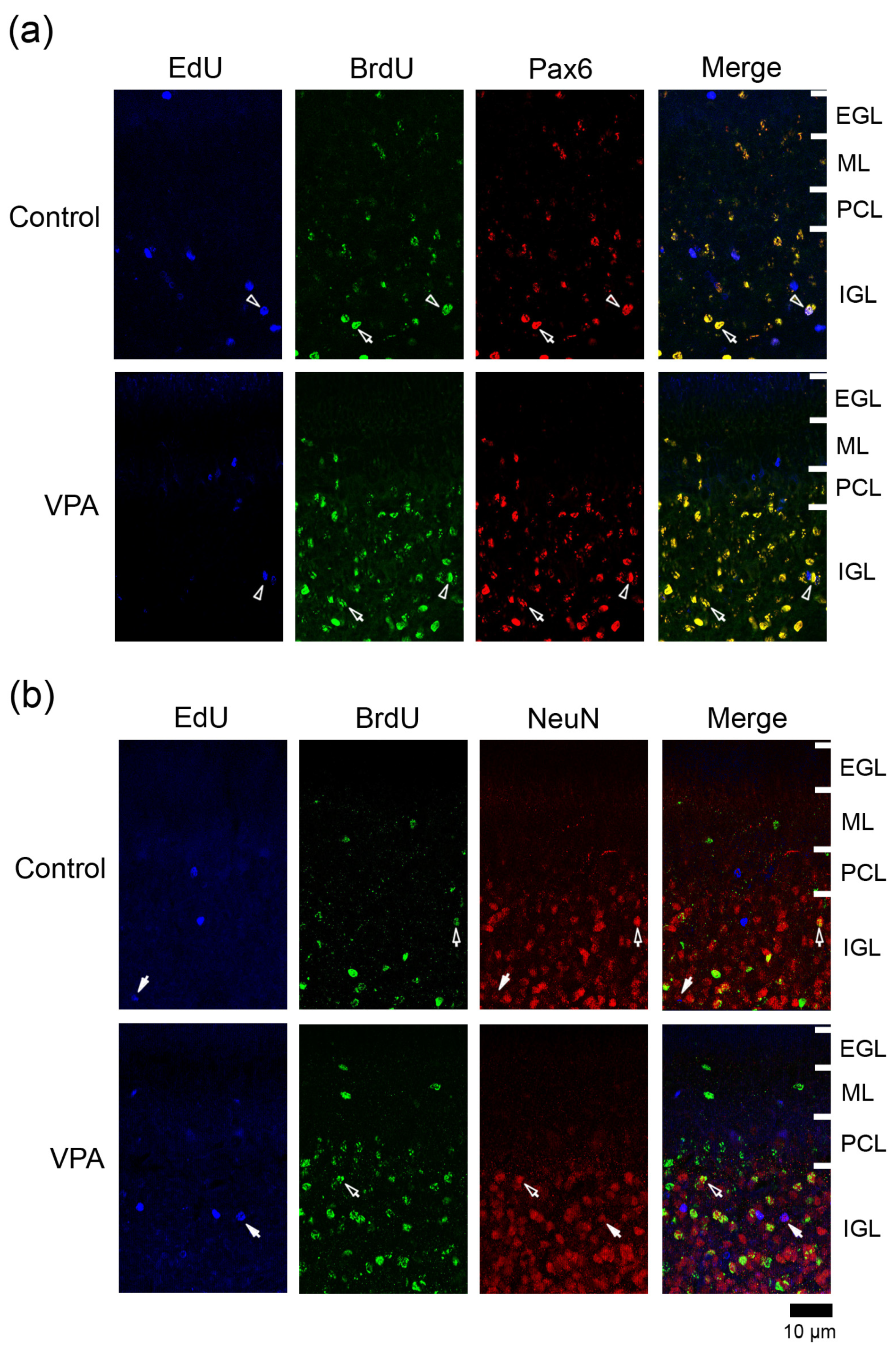
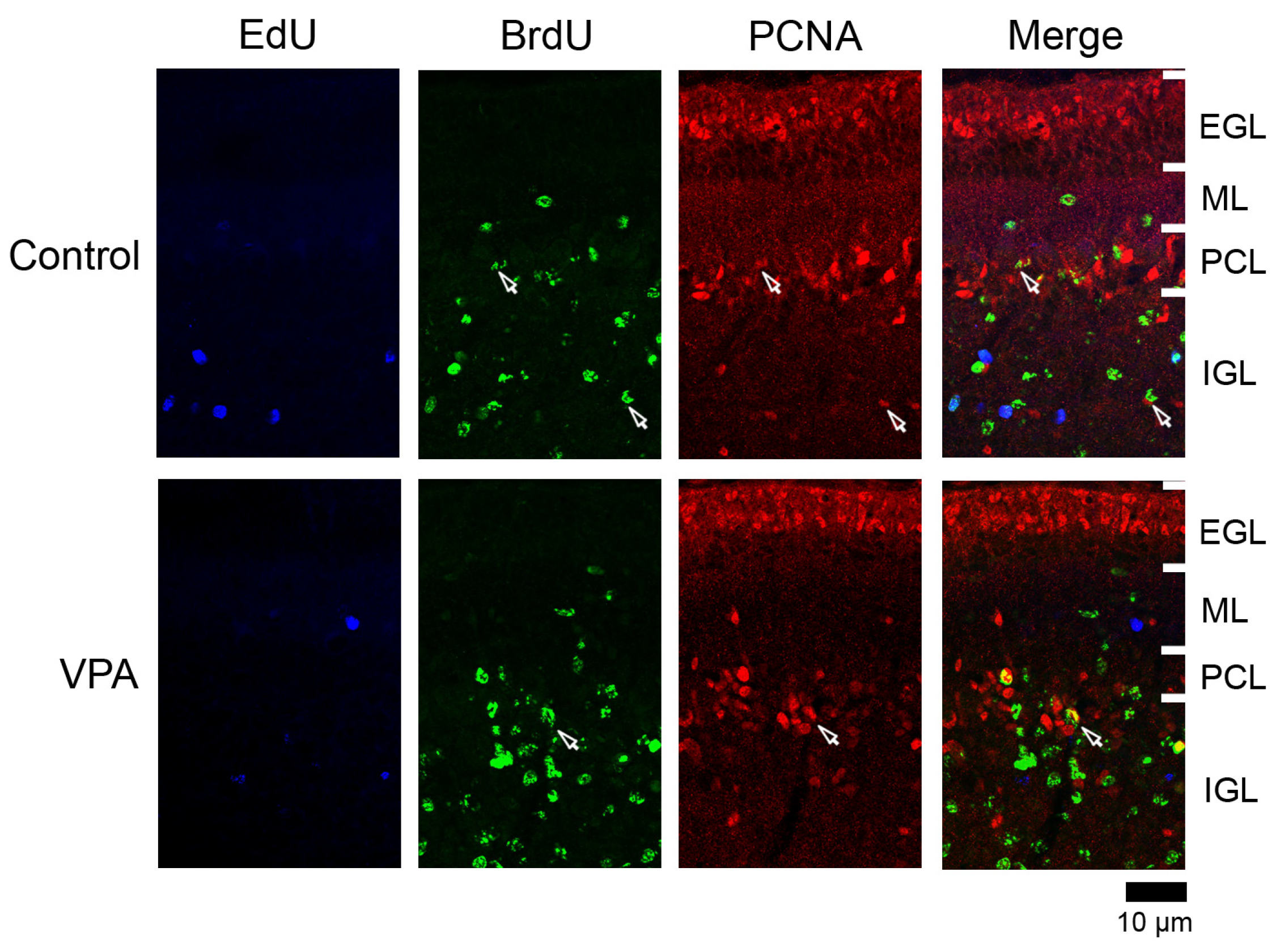
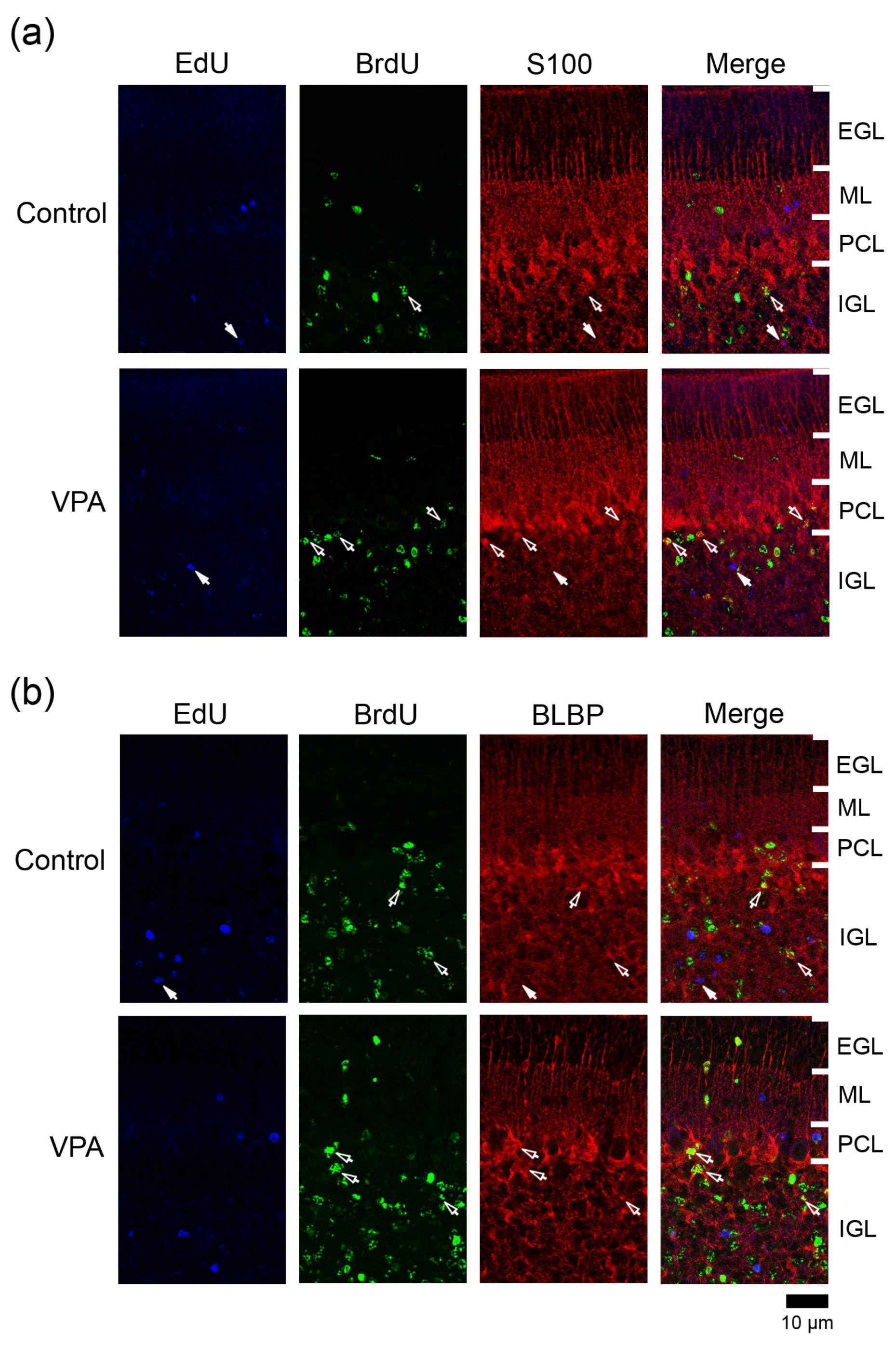

| Anterior Lobe | Posterior Lobe | |||
|---|---|---|---|---|
| Control | VPA | Control | VPA | |
| EdU-single labeled cells | ||||
| % of Pax6 | 0% (0/1) | 0% (0/3) | 100% (1/1) | 25% (1/4) |
| % of NeuN | 33.3% (1/3) | 50.0% (1/2) | 0% (0/3) | 50.0% (1/2) |
| % of PCNA | 0% (0/4) | 0% (0/5) | 0% (0/4) | 0% (0/1) |
| % of S100 | ND | 0% (0/2) | 0% (0/4) | 0% (0/3) |
| % of BLBP | 0% (0/2) | 0% (0/3) | 0% (0/4) | 0% (0/4) |
| BrdU-single labeled cells | ||||
| % of Pax6 | 50.0% (2/4) | 92.9% (13/14) * | 83.3% (5/6) | 100% (8/8) |
| % of NeuN | 14.3% (1/7) | 8.3% (1/12) | 60.0% (3/5) | 8.3% (1/12) * |
| % of PCNA | 0% (0/23) | 0% (0/13) | 0% (0/20) | 6.3% (1/16) |
| % of S100 | 11.8% (2/17) | 0% (0/15) | 0% (0/17) | 0% (0/15) |
| % of BLBP | 0% (0/17) | 0% (0/18) | 0% (0/9) | 0% (0/28) |
| Anterior Lobe | Posterior Lobe | |||
|---|---|---|---|---|
| Control | VPA | Control | VPA | |
| EdU-single labeled cells | ||||
| % of Pax6 | 33.3% (1/3) | 0% (0/4) | 12.5% (1/8) | 0% (0/5) |
| % of NeuN | 100% (3/3) | 25.0% (1/4) * | 100% (1/1) | 100% (1/1) |
| % of PCNA | 0% (0/2) | 0% (0/3) | 0% (0/3) | 0% (0/3) |
| % of S100 | 0% (0/14) | 10.0% (1/10) | 11.1% (1/9) | 0% (0/2) |
| % of BLBP | 0% (0/2) | 0% (0/7) | 0% (0/9) | 0% (0/6) |
| BrdU-single labeled cells | ||||
| % of Pax6 | 90.0% (9/10) | 100% (25/25) | 62.5% (10/16) | 100% (29/29) ** |
| % of NeuN | 100% (1/1) | 0% (0/11) | 40.0% (2/5) | 7.7% (1/13) |
| % of PCNA | 0% (0/14) | 31.3% (10/32) | 19.0% (4/21) | 41.0% (16/39) |
| % of S100 | 11.8% (2/17) | 45.0% (9/20) * | 0% (0/10) | 23.8% (5/21) * |
| % of BLBP | 0% (0/15) | 0% (0/38) | 0% (0/17) | 0% (0/36) |
| Anterior Lobe | Posterior Lobe | |||
|---|---|---|---|---|
| Control | VPA | Control | VPA | |
| EdU-single labeled cells | ||||
| % of Pax6 | 50.0% (2/5) | 15.4% (2/13) | 0% (0/8) | 11.8% (2/17) |
| % of NeuN | 80.0% (4/5) | 55.6% (5/9) | 33.3% (2/6) | 33.3% (4/12) |
| % of PCNA | 0% (0/11) | 33.3% (4/12) * | 11.1% (2/18) | 0% (0/16) |
| % of S100 | 0% (0/12) | 4.5% (1/22) | 0% (0/16) | 0% (0/34) |
| % of BLBP | 0% (0/7) | 0% (0/29) | 12.5% (1/8) | 9.5% (2/21) |
| BrdU-single labeled cells | ||||
| % of Pax6 | 85.9% (30/35) | 94.7% (108/114) | 79.1% (53/67) | 94.3% (100/106) ** |
| % of NeuN | 33.3% (10/30) | 44.6% (29/65) | 38.2% (21/55) | 57.5% (42/73) * |
| % of PCNA | 4.39% (3/61) | 17.9% (12/67) * | 7.0% (7/100) | 17.8% (12/129) * |
| % of S100 | 5.3% (4/75) | 7.3% (7/96) | 17.5% (11/63) | 14.9% (15/101) |
| % of BLBP | 2.6% (2/77) | 15.7% (16/102) ** | 2.8% (2/71) | 10.2% (10/98) |
Disclaimer/Publisher’s Note: The statements, opinions and data contained in all publications are solely those of the individual author(s) and contributor(s) and not of MDPI and/or the editor(s). MDPI and/or the editor(s) disclaim responsibility for any injury to people or property resulting from any ideas, methods, instructions or products referred to in the content. |
© 2024 by the authors. Licensee MDPI, Basel, Switzerland. This article is an open access article distributed under the terms and conditions of the Creative Commons Attribution (CC BY) license (https://creativecommons.org/licenses/by/4.0/).
Share and Cite
Kamiya, S.; Kobayashi, T.; Sawada, K. Tracking of Internal Granular Progenitors Responding to Valproic Acid in the Cerebellar Cortex of Infant Ferrets. Cells 2024, 13, 308. https://doi.org/10.3390/cells13040308
Kamiya S, Kobayashi T, Sawada K. Tracking of Internal Granular Progenitors Responding to Valproic Acid in the Cerebellar Cortex of Infant Ferrets. Cells. 2024; 13(4):308. https://doi.org/10.3390/cells13040308
Chicago/Turabian StyleKamiya, Shiori, Tetsuya Kobayashi, and Kazuhiko Sawada. 2024. "Tracking of Internal Granular Progenitors Responding to Valproic Acid in the Cerebellar Cortex of Infant Ferrets" Cells 13, no. 4: 308. https://doi.org/10.3390/cells13040308
APA StyleKamiya, S., Kobayashi, T., & Sawada, K. (2024). Tracking of Internal Granular Progenitors Responding to Valproic Acid in the Cerebellar Cortex of Infant Ferrets. Cells, 13(4), 308. https://doi.org/10.3390/cells13040308








